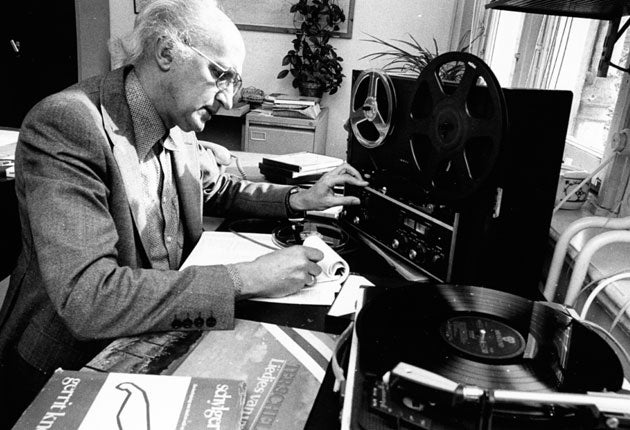Your support helps us to tell the story
From reproductive rights to climate change to Big Tech, The Independent is on the ground when the story is developing. Whether it's investigating the financials of Elon Musk's pro-Trump PAC or producing our latest documentary, 'The A Word', which shines a light on the American women fighting for reproductive rights, we know how important it is to parse out the facts from the messaging.
At such a critical moment in US history, we need reporters on the ground. Your donation allows us to keep sending journalists to speak to both sides of the story.
The Independent is trusted by Americans across the entire political spectrum. And unlike many other quality news outlets, we choose not to lock Americans out of our reporting and analysis with paywalls. We believe quality journalism should be available to everyone, paid for by those who can afford it.
Your support makes all the difference.Generally "legendary" is a word conferred recklessly, but the Dutch folksong collector and broadcaster Ate Doornbosch truly earned that accolade. A giant of folk-song scholarship, over the course of a life spent absorbing and disseminating folk song and traditional ballad, he transformed people's understanding of his native culture. Few folk-song collectors anywhere match Doornbosch's achievement, the public face of which was the long-running radio series Onder de Groene Linde ("Under the green linden"), which fed the Dutch folk revival and provided bands like Wolverlei and Fungus with raw material of the highest calibre.
Born in the village of Nuis in the northern province of Groningen in 1926, Ate Doornbosch was an adolescent when the Germans overran the country in May 1940. After the Netherlands was finally liberated in 1945, like many other nations occupied during the war, the country took stock and looked inwards. With reconstruction and reappraisal came fresh appreciations of what had been lost and what remained. In the Netherlands, the Commission for Codification of Dutch Folksongs recommended the creation of the Dutch Folksong Archive in 1953, later absorbed into Amsterdam's Meertens Instituut.
Two years previously, Doornbosch had joined VARA, a politically progressive broadcasting organisation with a policy of bringing educational material to its audience. The nature of this uplifting material – orchestral and choral music figured strongly – rankled with Doornbosch who proposed a series of ten programmes of old Dutch songs. An autodidact himself, he had a model in the field collector Will Scheepers who between 1950 and 1964 had amassed 2,000 recordings for the Meertens Instituut.
VARA baulked at his suggestion, but he held his ground and his wish came true. From 1957 he presented the radio programme Onder de Groene Linde, the "hero" of which was Dutch traditional song. In that post-war austerity era it got an estimated audience of 350,000 each broadcast. His first field-recording was of his wife's grandmother. From 1968 until 1993 the Dutch Radio Union aired the series. Doornbosch's truffling for narrative songs at the expense of other forms such as children's or work songs attracted criticism in some quarters. Better put, it was an indication of intent and focus and devotees taped entire shows off the radio. When he retired he had transmitted 1,316 programmes.
His work was fairly compared to that of the US collector Alan Lomax and, arguably less accurately, to that of Harry Smith – the latter better known as the compiler of Folkways' influential Anthology of American Folk Music than for his varied field recordings. It formed the central premise behind Louis Peter Grijp and Herman Roodenburg's Amsterdam University Press book, Blues en Balladen: Alan Lomax en Ate Doornbosch, Twee Muzikale Veldwerkers ("Blues and Ballads: Alan Lomax and Ate Doornbosch, two music fieldworkers", 2005).
Relatively little of this work obtained commercial release, though the French Ocora label put out Pays-bas: Chansons Oubliées – the Netherlands: Songs Adrift (1996) and there were songbooks. However, in December 2008, the culmination of a huge chunk of his life's work landed with a thud. Edited by Grijp and Ineke van Beersum, over nine CDs, with bilingual Dutch-English text, Music & Words' masterly and authoritative Onder de Groene Linde unashamedly focused on Doornbosch's special interest: narrative songs from the oral tradition. The accompanying DVD included Pier Tania's gloomily titled 1964 VARA documentary Het Einde Van Het Lied ("The end of the song").
Onder de Groene Linde was one of only 11 releases in all categories in Germany's 2009 Schallplattenkritik awards. Speaking for his fellow jurists, Folker magazine's Mike Kamp hailed it as "probably the most comprehensive collection ever released of songs from the Netherlands..." (Only the "probably" was debatable). That same year it scooped an Edison Music Award – his homeland's Grammy equivalent – in the "Special Edition World" category.
"He was pretty active right to the very last," Hans Peters, the head of Music & Words wrote to me, "as far as his body let him. I am glad we were able to release our box set two years ago and that he was able to accept the Edison personally last year and that he lived to see it all happen." Listening to random selections with me, the folk singer Anne Briggs described its music as "exquisite" and "a real labour of love".
His daughter Hilde survives him.
Ate Doornbosch, folk music collector and broadcaster: born Nuis, The Netherlands 1 January 1926; married 1951 Rinie Spu (deceased; one daughter); died Schiedam, Zuid-Holland 23 July 2010.

Join our commenting forum
Join thought-provoking conversations, follow other Independent readers and see their replies
Comments